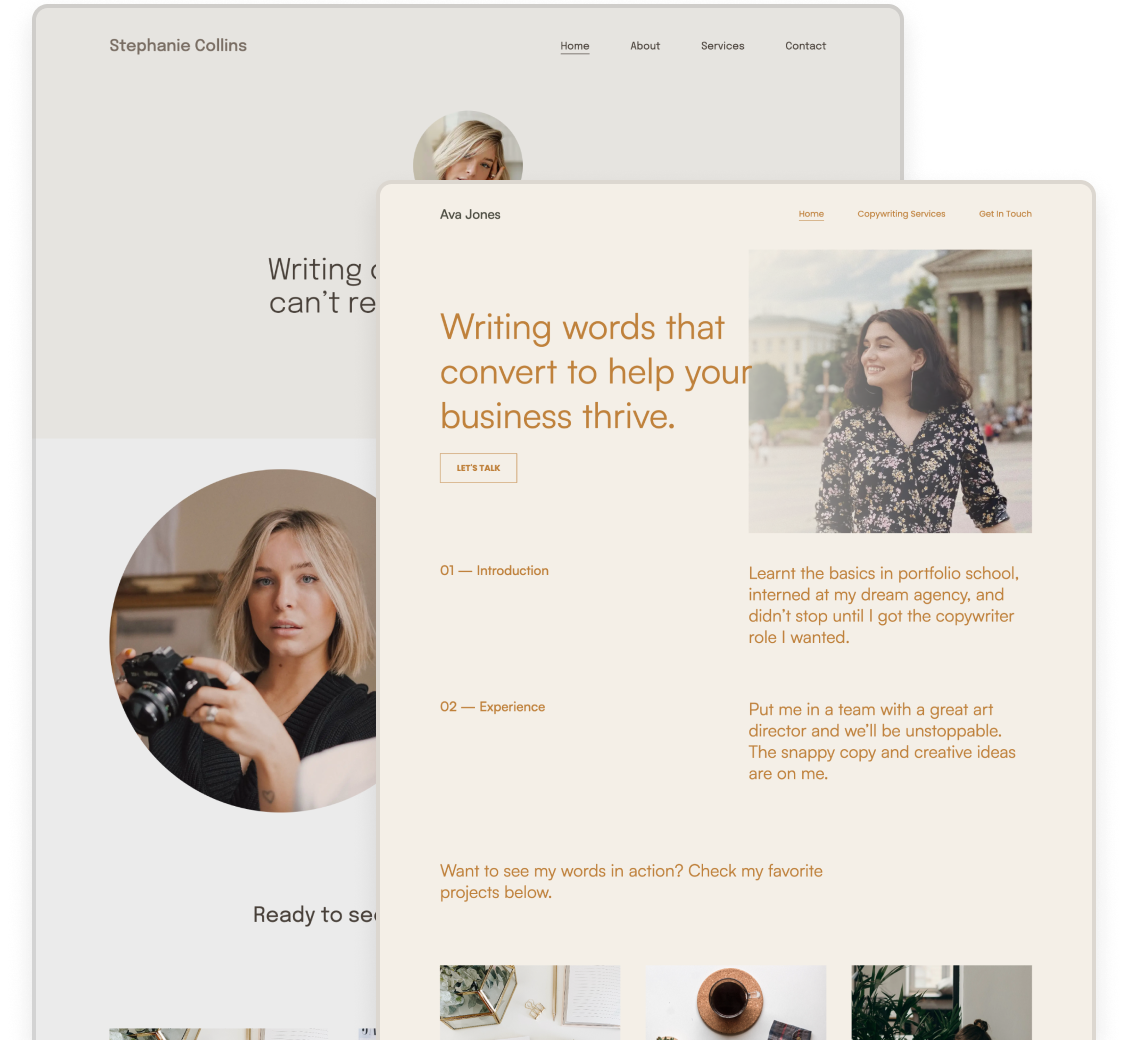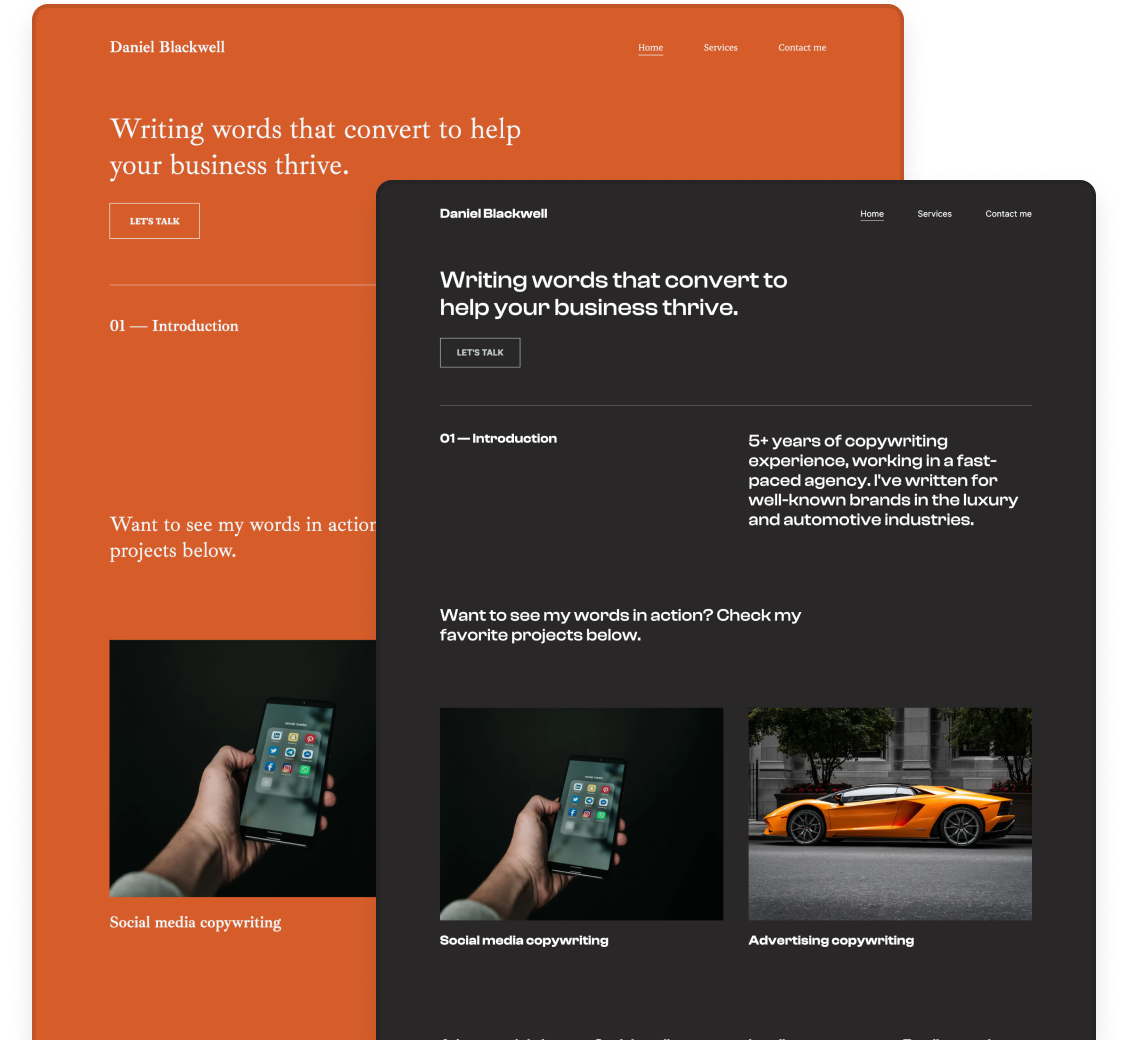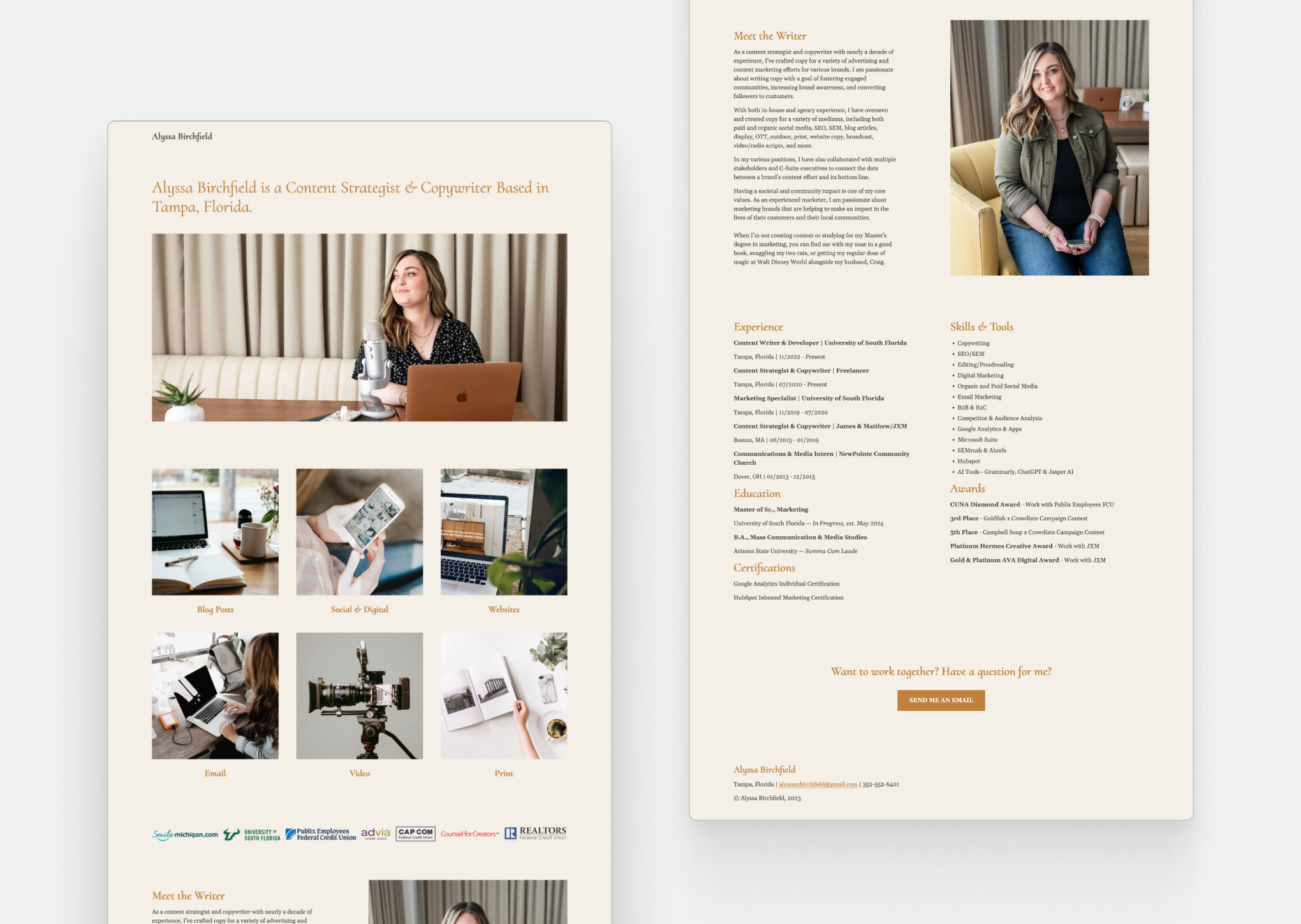How to Create A Copywriting Portfolio: The Ultimate Guide
Let’s pretend I’m your potential client. Or hiring manager. If I asked you to sweep me off my feet with your best work in just 10 minutes, would you be able to do that? If your answer is no –either because your copywriting portfolio is not outstanding, or worse, you don’t even have one… Then you should do something about it as soon as possible.
In this article, we'll discuss why it's important to always have an up-to-date and eye-catching portfolio. Then we'll show you step-by-step how to create one with a portfolio builder tool that'll save you hours of work, hundreds of dollars, and all the stress.
Don't worry, if you need some inspiration too, we have links to dozens of amazing copywriting portfolio examples at the end.
Why do you need a copywriting portfolio?
Typically, you’ll be in one of the two following situations:
- You can be a freelancer trying to find new clients and projects to work on,
- Or you can be looking for a new copywriter job, wanting to impress hiring managers.
Either way, you’ll need a copywriting portfolio to quickly prove that you’re the right person for the job.
For freelance copywriters
When you’re looking for a new client, they want to see a selection of your previous work, to assess your style and level of experience. You can send them your portfolio on your freelance writer website when you pitch your service or ideas to them –and often they might stumble upon your portfolio by themselves, when browsing the internet, looking for a copywriter.
For job hunting
When it comes to job hunting, the first thing you need to know is that a copywriter resume is just not enough. The larger companies, those big names everyone wants to work for, always ask for an online copywriting portfolio. Competition for these positions is always intense and they will only talk to you if your portfolio stood out from the crowd. You need to convince them you’re worth their time.
But it’s not just the big brands. Smaller companies also always ask for samples of your work. And it will probably come as no surprise, but they’ll only call those in for an interview, who submit a good-looking, easy-to-oversee portfolio. Preferably a nicely designed personal website. Don’t even think about dumping a bunch of PDFs on them!
Remember: you never know when an amazing opportunity will come your way, or when you’ll have to look for a new job. It’s important to always have an online presence and a great portfolio site, so that you’re ready when you need one unexpectedly.

The copywriting portfolio of Gari Cruz
What makes a good copywriting portfolio?
When you’re thinking about the ideal copywriting portfolio, you should always think about who’s going to be the one actually looking at it. Most likely hiring managers or potential clients, trying to choose between multiple applicants, each with their own materials to present. What that means is that they won’t have a lot of time to spend browsing through your website.
We’ve interviewed creative directors and people from HR departments and they all emphasized the same things when it comes to copywriting portfolios:
- It has to be easy to navigate and oversee. As they don’t have a lot of time for each person, they need to be able to see at the first glance, if it’s worth going into the details.
- Only include your best work. Coming back to the lack of time, it’s important to select your very best pieces. Make sure whichever they click on, it’s going to blow them away.
- It has to show your personality. With dozens or even hundreds of applicants to review, finding creative ways to make your portfolio “speak for itself”, showing off your personality is a great way to stand out from the crowd.
- Don’t forget about the extras. Yes, the most important part of your portfolio is showcasing your best projects - but it doesn’t end there. Have any of your projects won awards? Include them! Writer resumes and cover letters sound like a thing of the past? Not at all! Especially if you’re just starting out, a strong and motivated cover letter can turn it all around for you.
The homepage of Karly Nelson's copywriting portfolio, created with Copyfolio
The ideal copywriting portfolio layout and structure
Another important aspect of a successful copywriting portfolio is its overall layout and structure. It should have:
- A home page,
- About me page,
- Contact page,
- Pages detailing each project,
- Services page and
- Testimonials.
The portfolio home page
There are some pages you just have to have on your portfolio site. Probably the most obvious one is the home page. That’s where all your visitors land and get their first impressions. So it’s important to make it not only visually appealing but also easy to navigate. Your home page should have:
- Your basic info. It’s good to add a photo of yourself and a short bio, so the visitors can quickly get an idea of who you are and what you do.
- Social links. They might want to check you out on other platforms if your site got them interested. Why not make it easier and include icons that link to your profiles?
- Your CV. Clients and hiring managers like to see your background, but it wouldn’t be a good idea to clutter up your home or even about me page with that. Instead, include a link to your CV, so they can easily download it and see everything they want to know.
- Your top projects. Even if you don’t feature all of your projects on your home page, we recommend you to add at least 4-5 of them. With big, good-looking thumbnails the visitors won’t be able to resist clicking to find out more.
- Brands you worked with. If you had the chance to work with some big names in your writing career, it’d be a good idea to feature their logos. It shows authority and credibility towards the viewers. After all, if those companies decided to work with you, why shouldn’t they?
Ivy Jolin's copywriting portfolio website made with Copyfolio.
Tha contact page
Another non-negotiable is the contact page. Imagine this. You have an amazing portfolio and the client is wowed. They cannot wait to work with you. But there’s no contact page and they have no clue how to get in touch with you. No matter how much they liked your work, you just lost them right there. So make sure you include a contact page and make it easy to find.
Your about me page
Once you have these two set up, don’t forget about your “About me” page either. Even if you have a photo and short bio on your home page (which you should!), it’s good to have a separate page with more details. You don’t want to clutter up your home page by writing too much about yourself –but that doesn’t mean visitors wouldn’t want to get to know you better. It’s a perfect place to show your personality, to give them a glimpse into who’s behind all of this amazing work they see on the site.

The about page of Shanice's copywriting portfolio website, created with Copyfolio.
Projects and case studies
It’s the home page that helps visitors decide if they want to even stay and see more of your work. But it's the projects or case studies themselves that will determine whether they want to actually work with you.
You have to make sure that each project is
- clearly and briefly outlining the business goals, your process, and approach
- visually appealing with images, videos, or both by adding pictures to the video of the finished product, and
- gives credit, where credit is due (to developers, designers, art directors you worked with)
The aim of including the projects in your copywriting portfolio is to show the finished results for each, preferably in context, and also how it solved a business problem. People also like to see your reasoning and thought process behind it. But keep in mind that they won’t have hours to read through pages and pages of details.
Additional pages for freelancers’ portfolios
Apart from these, there are some pages that make more sense for freelancers and are just less relevant for in-house copywriters.
One such page that’s good to include is a services page, which is essential for every copywriting business. Copywriters are often either specialized in a certain niche –or the opposite, do other kinds of writings too, such as content or UX writing. The services page is the perfect place for you to detail what kind of jobs you can be booked for, and even specify your pricing if you want to.
It’s worth including testimonials from previous clients as well. Just as you read the reviews of a restaurant or hotel before you go, you’d probably hire someone more confidently if you see positive testimonials of their work.
These are the pages people will want to see if they are considering hiring you for a job, looking for more information on the business-side of your work.
What to include in your copywriter portfolio?
Now that you know how your portfolio should be structured, you might think… “Okay, but what should I actually put in it? How do I fill it up?” It's a hard question to answer, whether you’re a seasoned professional or a junior copywriter with no real work experience.
Different formats of copywriting you can include
When you sit down to select projects for your portfolio, think about the different formats you can include. As a general rule, unless you’re specializing in one specific format, it’s good to include a wide variety of them. This way you can show the viewer that you have the skills and expertise to complete a range of different projects.
The most common types of copywriting projects are:
- Website copy, such as landing pages and sales pages
- Email marketing copy
- Online ad copy, e.g. Facebook ads or Google ads
- Social media posts
- Print advertisements
- TV commercials or videos
- Radio spots or podcasts
If you have a specific client or brand in mind, you should check what formats they usually work with. If you’re trying to land a job with a brand that often advertises in magazines, write copy for magazine ads! Or similarly, if they’re super active on social media, show them you can write engaging posts using their brand voice. You get the gist.
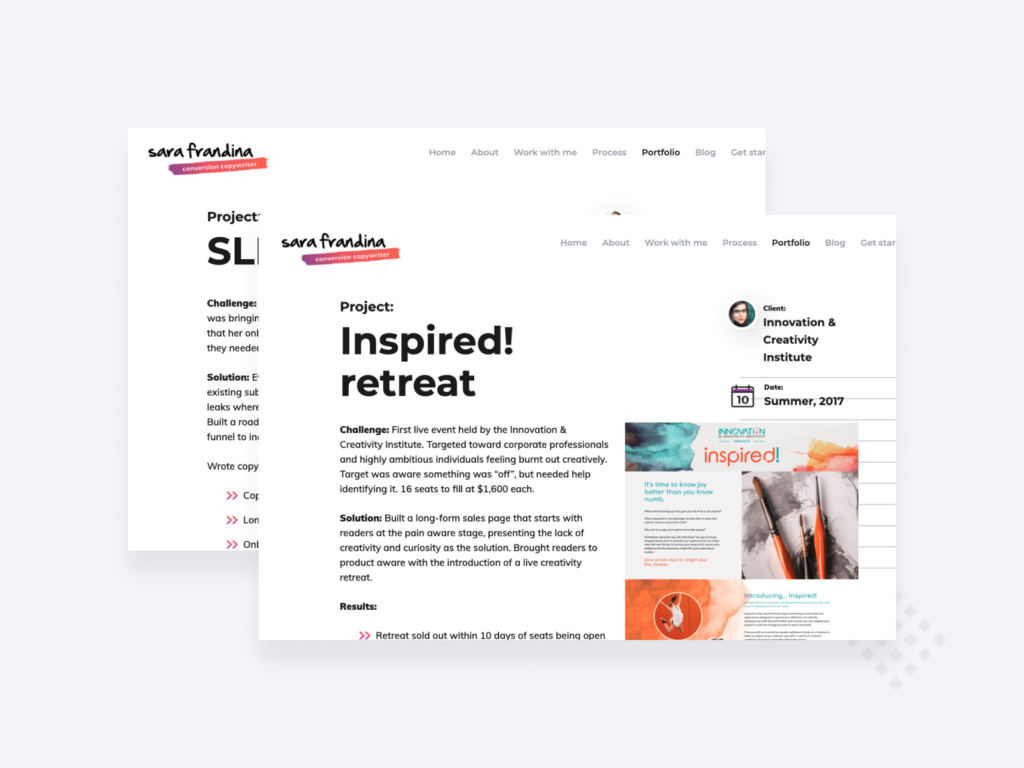
Case studies in Sara Frandina's copywriting portfolio
How to choose which copywriting samples to include?
It can be a struggle for experienced copywriters with years of experience to choose which samples to add to their copywriting portfolio. A lot of thought goes into picking the right projects even for a creative director portfolio. If you’re facing this problem, think of the following when selecting your projects:
- The viewers have limited time. This means you should limit the number of projects you include, and only choose the very best ones.
- Do you have a niche or are you a versatile writer? If there are multiple areas you can and like to write in, make sure to include a nice variety of topics to prove that. But if you are specialized in one niche, visitors should be able to see that at first glance too.
- Have any of your projects won awards? In the advertising and copywriting world, awards mean a lot. So if any of your projects won awards, you should include them, clearly displaying the award(s) on the project pages.
- Have you worked with well-known brands? Although you could have super exciting projects with creative solutions working for smaller brands, having big names amongst your clients still carries great weight. So if you do, include those projects on your page.
- Any passion projects that show your personality? Creative directors and HR managers told us during interviews that they like to see some personality in copywriting portfolios. So if you have a project that’s near and dear to your heart, and points you in the direction of your dreams, include it!
After considering these five aspects, you will be able to easily select the projects worthy of being in your copywriting portfolio.
But if you have a very wide array of amazing samples, of different formats and niches, consider creating multiple portfolios. The design and structure can be the same, but tailor it to the specific type or industry. This way you won’t have to leave out any outstanding pieces. And when you’re pitching to a client or applying for a job, just choose and send the more suitable one.
Alyssa Birchfield's copywriter website, made with Copyfolio's Artboard template.
What if you don’t have much copywriting experience?
Don’t worry, you can build a great copywriting portfolio, even if you’re just starting out, aiming to become a copywriter now. There are websites that give you tips and techniques to create samples that will show your skills, even if they’re not real, big projects accumulated from years of experience.
Write spec ads and make up projects
One commonly used practice is writing so-called spec ads, or simply making up projects. Spec ad is short for speculative advertisement and it’s used for ads that you wrote, but which have never been published. You can choose an existing campaign and rewrite it, showing your thought process behind it –or just select a brand and product you love and create a fictitious advertisement for them.
When you make up a project for a real or non-existing brand or product, just make sure you outline the following just as you would in a real case study:
- What does the company do and what is the product?
- What is the problem your copy has to solve?
- What is the goal of the project?
- What was your thought process, when coming up with the solution?
- What is the solution you came up with? Show us the finished product!
- + Is there a way to measure the impact of it? If so, how would you do that?
Clients and HR managers won’t care if that was a real, paying project - they just want to see your copywriting skills through the process and end result.
Offer to work for NGOs, charities, or friends
Another great way to gain experience and some projects to fill your empty copywriting portfolio is to offer your services for free or for a symbolic price to organizations you’d like to support. They often lack the budget to hire professional copywriters and would appreciate the help. Just make sure to clarify that you’d like to use the piece in your portfolio later.
Or if there are no such organizations or charities around, you can even ask your friends to see if any of them could use a little copywriting help for their business, or personal projects.
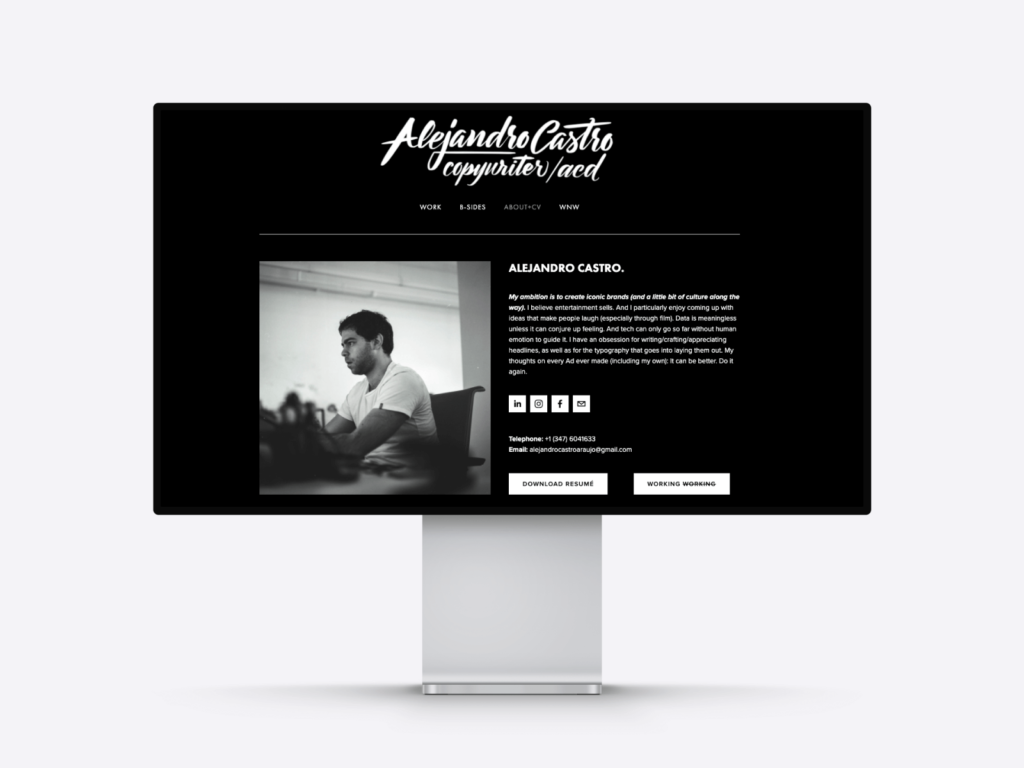
Screenshot of Alejandro Castro's copywriter website
How to present copywriting material visually?
Back in the day, a copywriter’s portfolio (or as it was called back then, their book) consisted of a folder with a selection of their best writings. It was simply printed page by page, in black and white. As you can imagine, this form of presentation wouldn’t do today.
Even though the value is still in the writing itself, with more and more beautiful and creative copywriting portfolios popping up, it would be hard to impress anyone with just a pile of text. Not to mention that you need to see the text in context with the accompanying visuals, for it to make sense.
At the same time, one of the biggest struggles writers experience is visualizing their written materials. “I’m not a designer”, they often say. We completely understand the frustration, so let’s see a few ways for solving that problem.
Screenshots
One of the easiest ways to show your copy in a visual way is to simply take a screenshot of the finished, published work. Whether it’s an email, landing page, or Facebook ad –it probably looks better live than just the text alone, without all the surrounding design elements.
Another reason for always taking a screenshot of your work is that the piece might not be accessible online for years to come. Or even available for everyone. It makes more sense for emails and hidden landing pages, but what about articles and main website copy?
It happens sometimes that the client or company decides to modify something later, take it off their site –or they might even go out of business and delete their entire website. So if you were planning on just linking to the piece, so that others can see it live… That’ll become pretty problematic if any of these happens. But if you have a screenshot, you can show the content in all its original glory, even if it's not online anymore.

Using screenshots and mockups in a case study, created with Copyfolio
Mockups
Another great way of presenting your copy visually is by using mockups. Mockups are images of computers, tablets, phones, or even print materials. You can add your image to make it look like it was displayed there originally. It helps with imagining what your copy would look like - especially if it is a made-up project that was never actually displayed anywhere. Not to mention it looks so much better than just a regular screenshot.
You can find lots of free mockups online - although you’ll need at least some basic Photoshop skills to embed your image nicely. Just make sure that if you use mockups, you do it well, because dodgy visuals can ruin the overall look.
Don't have any fancy design software? Then just add your screenshots to mockups right within Copyfolio with a single click!
Collaborate with graphic designers
If you’re a copywriter, you’ve likely worked with art directors or graphic designers on projects before. One way to create visuals for your copy is to ask one of them to help you out. It’s great because you can be pretty sure it’s going to look good. But keep in mind that you’ll be depending on that person. They might charge you or it might take a lot of time… and there’s no guarantee that they will always be readily available, whenever you want to add to it or make a few changes.
Where to host your copywriting portfolio?
Now you know how to create a good copywriter portfolio: what pages you need, what kind of projects to include, and how to visualize your work. But how do you put it to practice and actually build that badass portfolio? Let’s go into more detail on that.
There are multiple ways to approach this and many platforms to host your portfolio, such as:
- Choosing a social media platform. Some platforms like Instagram are heavy on visuals and so more suitable for designers or photographers. You could still consider one like LinkedIn, which gives you more freedom with words and uploading files. However, keep in mind that you cannot customize the page itself, so it will never be truly unique for you.
- Collecting your samples on Google Drive. You can create a Google Drive folder and upload your documents there to share with potential clients and managers. It’s free and easy to upload, but might be overwhelming and not a very visually appealing way of presentation.
- Building a custom website. Building a website from scratch for your portfolio sounds cool, but there’s a downside. You’ll either have to know how to code or be willing to pay hundreds or even thousands of dollars for a developer to do it for you. And then we haven’t even gotten started on creating the design and the visuals for it.
So instead, you could...
Using a copywriting portfolio builder tool
Did you know that there’s a portfolio builder tool, designed for copywriters?
All you have to do is choose your profession (copywriter) and your goal (build a portfolio) and you'll get a website with customized content. Upload your own images, add your projects, modify the copy a bit —and you're all done.
It's super quick and easy.
If you want to tailor it to your personal brand and elevate your digital presence, you can also:
- Create a custom color palette and apply it to your whole site with a single click
- Buy a custom domain that'll automatically get connected to your site, including an SSL certificate
- Set a custom favicon, so your portfolio's browser tab is easily recognizable
- Customize your SEO settings like meta titles and descriptions, so people can find you in search more easily
Click here to sign up and create your copywriting portfolio today!
Want to see lots of examples of sites created with Copyfolio?
👉 Check out our monthly featured #madewithCopyfolio sites.
Want to see copywriting portfolios specifically?
👉 Check out our article dedicated to copywriting portfolio examples!
How to create a copywriting portfolio: step-by-step
Save this list for when you're ready to jump into it and create your copywriting portfolio. Here's how.
1. Complete the top of your portfolio homepage. This is what people see first, so make this first impression impeccable. Write a strong headline and upload a convincing picture of yourself if you have one.
2. Add your copywriting case studies. If you're in a pinch, you can upload PDFs or add external links, but for the best-converting portfolio, write briefly about the project and your creative process, then show the finished results and its performance.
3. Choose your project thumbnails and adjust the design. This step is for the look and feel. Select thumbnails that match and adjust your site's design (color palette and fonts) to match them and your personal brand.
4. Write your about me page or section. It can be a few paragraphs on your homepage or it can have a dedicated page. Introduce yourself, and build a personal connection, but keep it professional.
5. Get your own domain and take care of the technical details. For a truly professional impression, everything needs to be in place. Grab a custom domain for a URL, fill out all pages' meta data, and set a custom favicon.
